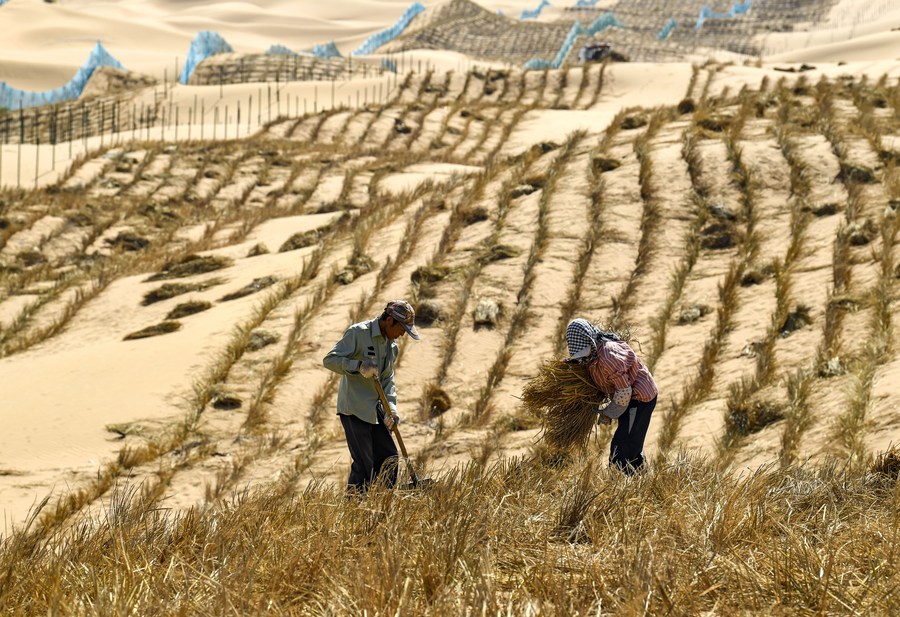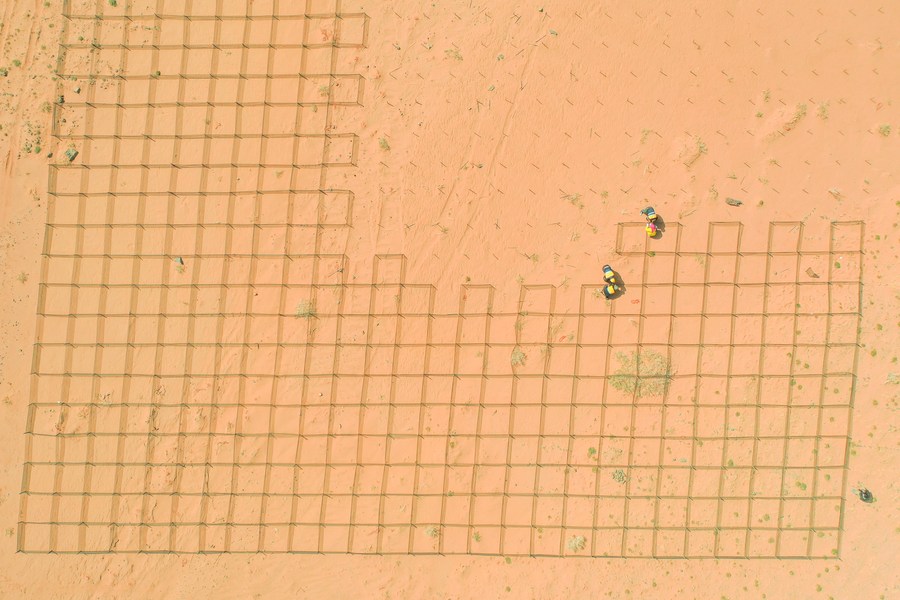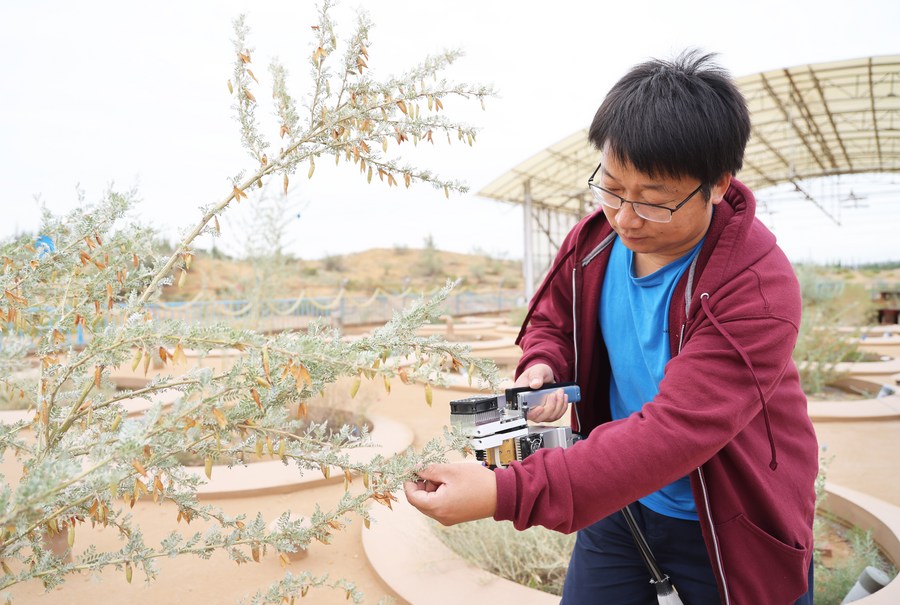
A strong wind blew over Zhongwei, a city near the Tengger Desert in northwest China's Ningxia Hui Autonomous Region, one of the driest places in the country, covering everything with a thin layer of dust.
Zhao Yang, an associate fellow at Shapotou Desert Research and Experiment Station (SDRES) of the Chinese Academy of Sciences (CAS), was working in a lab culturing a kind of cyanobacteria that is key to new desert-control technology.
The station was the birthplace of vast stretches of artificial straw-checkerboard, a technique to stop sand encroachment that was implemented in China over 60 years ago.
Today, Chinese researchers at SDRES are dedicated to developing new techniques to combat desertification in China, which in the past 20 years has contributed to the world's largest greening areas.

File photo taken on Sept. 7, 2020 shows desertification control workers making straw checkerboard barriers in the Tengger Desert along the construction site of the Qingtongxia-Zhongwei section of the Wuhai-Maqin highway in northwest China's Ningxia Hui Autonomous Region. (Xinhua/Feng Kaihua)
COMBATING DESERTIFICATION
Zhao is happy to see the progress taking place with the new desert-control technique.
According to Zhao, it naturally takes about 10 years to form a cyanobacteria crust on the surface of the sand that can prevent it from moving. However, by hybridizing a special bacterial strain extracted from the biological soil crust in the Tengger Desert with the cultured cyanobacteria, researchers at SDRES have successfully cut the crust formation time to only one year.
"The new technique has been implemented. The experimental field under my supervision alone is as large as 33.3 hectares, not to mention the fields supervised by my colleagues in other parts of China," said Zhao, who has been working at SDRES for 11 years.
Zhao's work is a microcosm of China's efforts to combat desertification, which dates back over 60 years ago.
When China's first railway through the Tengger Desert began operation in 1958, foreign experts who were invited to design the railway had predicted that it would be buried by sand in 30 years.
However, Chinese researchers' wisdom gave them a way out. Straw structures, which resemble checkerboards, proved to be the most convenient, environmentally friendly and cheap way of stopping sand encroachment. Within the checkerboards, the surface of the sand forms a hard crust over time which prevents the sand from moving.
With ample sand-control experience, Ningxia is building its first highway crossing the Tengger Desert, which is expected to be completed in 2021.
In recent years, China has pushed ahead with its greening efforts across the country. Official data showed that in 2020 alone, the country improved the ecology of 2.83 million hectares of grassland and carried out desertification prevention-and-control work on over 2.09 million hectares of land.

Aerial photo shows workers making grids to contain the moving sand dunes along Linhe-Ceke railway in north China's Inner Mongolia Autonomous Region, April 14, 2021. (Xinhua/Liu Lei)
SHARING EXPERIENCE WITH THE WORLD
While making headway in combating desertification over the past decades, China shared its techniques and experience in sand control with other countries.
In 1977, China shared the anti-desertification technique used in Shapotou at the UN Conference on Desertification in Nairobi. Dry straw checkerboards have now been used in many parts of the world as an effective way to combat desertification.
"The Chinese experience can benefit the world," said Iraqi agricultural engineer Sarmad Kamil Ali, who was in China in 2013 to learn about sand control.
"The Chinese always surprise the world with creative methods to overcome the difficulties they face. They have different methods to fix the dunes, and I found out recently that they are using more advanced technologies in fixing the sand dunes," he said.
Since 2005, the research team from Xinjiang Institute of Ecology and Geography (XIEG) of the CAS has been exporting mature desertification control technologies to Central Asia and Africa.
Demonstration bases have been built in many countries, such as those for ecological restoration of shrub grassland in Ethiopia, desert plants breeding and mechanical desertification control in Mauritania, according to Zhang Yuanming, head of the XIEG.
Noam Weisbrod, director of the Jacob Blaustein Institutes for Desert Research at the Ben-Gurion University of the Negev in Israel, was impressed by the sand control efforts during his trip to China's Inner Mongolia Autonomous Region several years ago.
The impact of climate change is very similar in different drylands around the globe, Weisbrod told Xinhua in an interview. "I'm a great believer in international cooperation. There is a lot of room for Israel-China cooperation on these topics."

A researcher examines plants at Shapotou Desert Research and Experiment Station (SDRES) of the Chinese Academy of Sciences (CAS) in northwest China's Ningxia Hui Autonomous Region, June 16, 2021. (Xinhua/Lu Ying)
DESERT BIODIVERSITY
Despite China's achievements in desert control, researchers believe that the country's anti-desertification methods still need to withstand the test of time.
"We should not be complacent with what we have found in desert control," said the SDRES director Li Xinrong. "We need to do more theoretical research in the field."
For Li, the ultimate goal of sand control is not to eliminate the deserts, but to improve the biodiversity of desert ecosystems and find a way for humans and deserts to live harmoniously.
"Deserts are an indispensable part of nature and a valuable resource," said Li. "The Earth would not be a beautiful place without them." (Xinhua)

86-10-68597521 (day)
86-10-68597289 (night)

52 Sanlihe Rd., Xicheng District,
Beijing, China (100864)

